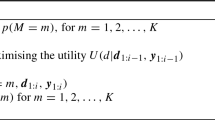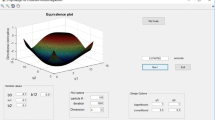Abstract
We consider the problem of A-optimal design of experiment under a Bayesian probabilistic model with both categorical and continuous response variables. The utility function of the local design problem is derived by applying Bayesian experimental design framework. We also develop an efficient optimization algorithm to obtain the local optimal design by combining the particle swarm optimization and the blocked coordinate descent methods. In addition, we discuss two different ways of constructing the global optimal design based on the algorithm for local optimal design. Simulation studies are presented to illustrate the efficiency of our approach.





Similar content being viewed by others
Notes
Linear-optimal (or L-optimal) criterion is defined by a linear function of the information matrix. For linear regression model with the model matrix \({\varvec{F}}\), the information matrix \({\varvec{M}}=({\varvec{F}}'{\varvec{F}})^{-1}\), and the L-optimal criterion is \(L({\varvec{M}})\), and \(L(\cdot )\) is a linear function. A-optimality is a special case of L-optimality because \(L({\varvec{M}})=\text{ tr }({\varvec{A}}\times {\varvec{M}})\) is a linear function of \({\varvec{M}}\). More details can be found in [22].
We have used the following formulas of matrix-to-scalar derivative in our calculations: \(\frac{\partial \text{ tr }(U)}{\partial x}=\text{ tr }(\frac{\partial U}{\partial x})\),\(\frac{\partial UV}{\partial x}=U\frac{\partial V}{\partial x}+\frac{\partial U}{\partial x}V\), \(\frac{\partial U^{-1}}{\partial x}=-U^{-1}\frac{\partial U}{\partial x}U^{-1}\).
References
Deng X, Jin R (2015) QQ models: joint modeling for quantitative and qualitative quality responses in manufacturing systems. Technometrics 57(3):320–331
Kang L, Kang X, Deng X, Jin R (2018) A Bayesian hierarchical model for quantitative and qualitative responses. J Qual Technol 50(3):290–308
Kang L (2016) Bayesian d-optimal design of experiments with continuous and binary responses. In: International conference on design of experiments (ICODOE-2016)
Eberhart RC, Kennedy J et al (1995) A new optimizer using particle swarm theory. In: Proceedings of the sixth international symposium on micro machine and human science, vol 1, pp 39–43. New York, NY
Lukemire J, Mandal A, Wong WK (2016) Using particle swarm optimization to search for locally \(d\)-optimal designs for mixed factor experiments with binary response. arXiv preprintarXiv:1602.02187
Chen R-B, Chang S-P, Wang W, Tung H-C, Wong WK (2015) Minimax optimal designs via particle swarm optimization methods. Stat Comput 25(5):975–988
Wong WK, Chen R-B, Huang C-C, Wang W (2015) A modified particle swarm optimization technique for finding optimal designs for mixture models. PLoS ONE 10(6):e0124720
Chen R-B, Hsu Y-W, Hung Y, Wang W (2014) Discrete particle swarm optimization for constructing uniform design on irregular regions. Comput Stat Data Anal 72:282–297
Leatherman E, Dean A, Santner T (2014) Computer experiment designs via particle swarm optimization. In: Topics in statistical simulation, pp 309–317. Springer
Kang L, Joseph VR (2012) Bayesian optimal single arrays for robust parameter design. Technometrics
Wu CFJ, Hamada MS (2011) Experiments: planning, analysis, and optimization, vol 552. Wiley, Hoboken
Ai M, Kang L, Joseph VR (2009) Bayesian optimal blocking of factorial designs. J Stat Plan Inference 139(9):3319–3328
Joseph VR (2006) A Bayesian approach to the design and analysis of fractionated experiments. Technometrics 48(2):219–229
Lindley DV (1972) Bayesian statistics: a review, vol. 2. SIAM, Philadelphia
Chaloner K, Verdinelli I (1995) Bayesian experimental design: a review. Stat Sci 10(3):273–304
Ryan EG, Drovandi CC, McGree JM, Pettitt AN (2016) A review of modern computational algorithms for Bayesian optimal design. Int Stat Rev 84(1):128–154
Overstall AM, Woods DC (2017) Bayesian design of experiments using approximate coordinate exchange. Technometrics 59(4):458–470
Drovandi CC, Tran M-N et al (2018) Improving the efficiency of fully Bayesian optimal design of experiments using randomised quasi-monte carlo. Bayesian Anal 13(1):139–162
Woods DC, Overstall AM, Adamou M, Waite TW (2017) Bayesian design of experiments for generalized linear models and dimensional analysis with industrial and scientific application. Qual Eng 29(1):91–103
Alexanderian A, Gloor PJ, Ghattas O et al (2016) On Bayesian a- and d-optimal experimental designs in infinite dimensions. Bayesian Anal 11(3):671–695
Huan X, Marzouk YM (2013) Simulation-based optimal Bayesian experimental design for nonlinear systems. J Comput Phys 232(1):288–317
Fedorov VV (1972) Theory of optimal experiments (translated by W. J. Studden and E. M. Klimko, eds.). Academic Press, New York
Kiefer J (1985) Collected papers, vol 3. Surendra Kumar
Yu Y (2011) D-optimal designs via a cocktail algorithm. Stat Comput 21(4):475–481
Yang M, Biedermann S, Tang E (2013) On optimal designs for nonlinear models: a general and efficient algorithm. J Am Stat Assoc 108(504):1411–1420
Acknowledgements
This research was supported by U.S. National Science Foundation Grants CMMI-1435902.
Author information
Authors and Affiliations
Corresponding author
Ethics declarations
Conflict of interest
On behalf of all authors, the corresponding author states that there is no conflict of interest.
Additional information
Publisher's Note
Springer Nature remains neutral with regard to jurisdictional claims in published maps and institutional affiliations.
Part of special issue guest edited by Pritam Ranjan and Min Yang—Algorithms, Analysis and Advanced Methodologies in the Design of Experiments.
Appendices
Appendices
1.1 A Proof of Theorem 1
For the A-optimal design, the design criterion is
It can be easily seen that
Also, in the last equation of \(\Phi ({\varvec{X}})\), the integration with respect to \({\varvec{\eta }}\) in the last two terms cannot be computed explicitly. So for the local optimal design, we omit the integration with respect to \({\varvec{\eta }}\) and instead let the objective function depend on \({\varvec{\eta }}\).
Thus the objective function for the local optimal design is
According to the conditional posterior distribution of \({\varvec{\beta }}_i^{(i)}\),
In Lemma 1, we prove the following
Here \({\varvec{V}}_1=\text{ diag }\{{\varvec{z}}\}\), \({\varvec{V}}_2={\varvec{I}}_n-{\varvec{V}}_1\), \({\varvec{W}}_1=\text{ diag }\{{\varvec{\pi }}\}\),\({\varvec{W}}_2={\varvec{I}}_n-{\varvec{W}}_1\), and
With this result, we can reach the result in Theorem 1.
Lemma 1
Define function \(Q_i({\varvec{b}}) = \sigma ^2\text{ tr }[{\varvec{A}}_i{\varvec{C}}_i^{-1}({\varvec{b}})]\). Then (21) can be rewritten as
Proof
Performing second-order Taylor expansion to \(Q_1({\varvec{z}})\) at \({\varvec{z}}={\varvec{\pi }}\), we have
Taking expectation to (23) yields
It remains to compute \(\frac{\partial ^2 Q_i({\varvec{z}})}{\partial z_k^2}\). We haveFootnote 2
and
Substituting this into (24) yields (22) and (21). This completes the proof. \(\square\)
B Practical Justification of the Negligibility of \(E[o(||{\varvec{z}}-{\varvec{\pi }}||^2)]\)
In this section, we show that \(E[o(||{\varvec{z}}-{\varvec{\pi }}||^2)]\) is negligible in general computation setting, and thus, ignoring \(E[o(||{\varvec{z}}-{\varvec{\pi }}||^2)]\) in (12) still comprises a good approximation of the exact objective function.
First, we generate \(M=1000\) random samples of \({\varvec{z}}_m\)’s from the distribution (4) for a given \({\varvec{\eta }}\) value and compute \(\text{ tr }[{\varvec{A}}_i\cdot \text{ var }({\varvec{\beta }}^{(i)}|{\varvec{X}},{\varvec{y}},{\varvec{z}}_m)]\). Then, we replace \(E_{{\varvec{z}}}\{\text{tr }[A\cdot \text{ var }({\varvec{\beta }}^{(i)}|{\varvec{X}},{\varvec{y}},{\varvec{z}})]\}\) by its sample mean \(\frac{1}{M}\sum _{m=1}^M\text{ tr }[{\varvec{A}}_i\cdot \text{ var }({\varvec{\beta }}^{(i)}|{\varvec{X}},{\varvec{y}},{\varvec{z}}_m)]\) in (20), and thus we estimate the exact objective function by
where \(Q_0\) only depends on \({\varvec{\eta }}\) but not \({\varvec{z}}\). We denote Q as the approximated objective value computed by dropping \(E[o(||{\varvec{z}}-{\varvec{\pi }}||^2)]\) from (20), i.e.,
and none of these terms in Q depends on \({\varvec{z}}\)
To set up a simulation study to compare Q and \(Q_{MC}\), we take the same candidate points as the simulation in Sect. 4.1, but we use different parametric settings. For each run of the simulation, we sample \(r_0,r_1,r_2\) uniformly from (0, 1), \(\rho\) uniformly from (0, 10), and \({\varvec{\eta }}=\eta \cdot {\mathbf {1}}_7\) where \(\eta\) is uniformly sampled from (0, 20). We fix \(\sigma ^2\) to be 1 and the matrix \({\varvec{A}}\) is fixed as in Sect. 4.1 since they have only a scaling effect on the objective function. We repeat 1000 such runs, and for each run, we compute the relative error \(100\%(\frac{Q-Q_{MC}}{Q_{MC}})\). Figure 6 shows the histogram of 1000 values of this relative error in percentage. We can see that most of its values are centered around 0 and more than \(93\%\) of them are within the range \((-1\%,+1\%)\). Therefore, we conclude that Q provides a good approximation of \(Q_{MC}\). Since their difference is a realization of \(E[o(||{\varvec{z}}-{\varvec{\pi }}||^2)]\), this indicates that \(o(||{\varvec{z}}-{\varvec{\pi }}||^2)\) is practically negligible on average.
To get a better understanding of how close Q and \(Q_{MC}\) are, we fix \(r_0=0.3\), \(r_1=0.4\), \(r_2=0.5\) and \(\rho =5\). The values of \(\sigma ^2\) and \({\varvec{A}}\) are set the same as above. We only vary \(\eta\) as in \({\varvec{\eta }}=\eta \cdot {\mathbf {1}}_7\) from very small to relative large, since \(\eta\) controls how close \(V_i\) and \(W_i\) are. The values of Q and \(Q_{MC}\) computed based on different \(\eta\) values are listed in Table 1, from which we can see that Q well approximates \(Q_{MC}\) regardless of \(\eta\).
Rights and permissions
About this article
Cite this article
Kang, L., Huang, X. Bayesian A-Optimal Design of Experiment with Quantitative and Qualitative Responses. J Stat Theory Pract 13, 64 (2019). https://doi.org/10.1007/s42519-019-0063-6
Published:
DOI: https://doi.org/10.1007/s42519-019-0063-6





